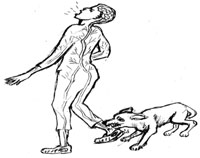Clinical manifestations and diagnosis of rabies
From the site of the bite, the virus goes to the central nervous system (figure below) and causes the clinical manifestations which, if untreated, eventually lead to death.
Rabies has the highest case-fatality rate of any communicable disease. After an incubation period usually lasting one to three months, but sometimes even up to one year after the bite, the patient develops symptoms that are similar to many other illnesses – fever, headache and general weakness. The speed of progression is faster if the original site of infection was in an area of the body that is close to the spinal cord or brain, e.g. a bite on the face or hands.
As the disease gets worse, the patient experiences anxiety, confusion, difficulty sleeping, hallucination (seeing things that aren't there), spreading paralysis (inability to move the muscles), difficulty swallowing and convulsions (uncontrollable shaking).
A characteristic sign of late-stage rabies in some patients is hydrophobia (fear of water), which manifests in the patient reacting in terror if a bowl of water is brought near. This form of the disease (known as 'furious' rabies) prevents the patient from drinking and speeds the arrival of death within a few days. Other patients become increasingly paralysed and lose consciousness before death.

Diagnosis is made on the basis of these clinical signs. There are no tests to confirm rabies with absolute certainty while the patient is still alive. Viruses can be detected by laboratory investigation of the patient's brain after death, but this test is not usually carried out in countries with few resources.